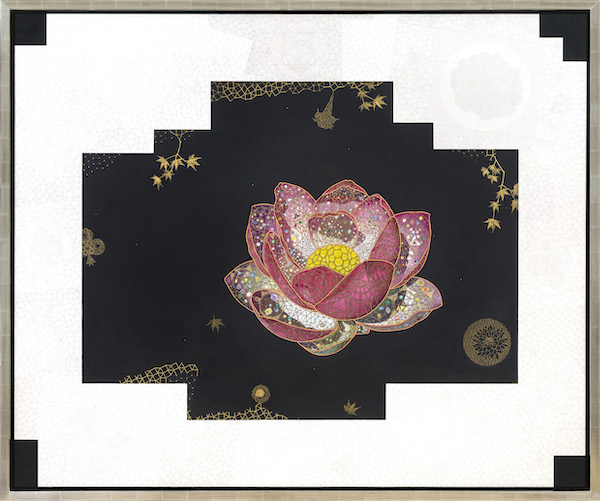We live in a time when the value of the work of art in society has changed radically. In February, the whole mercantile mechanism of the art world was in full swing, and by the end of March, with the global pandemic, life as we have known it had more or less stopped. With everything on pause, Tom Wudl’s show “The Flowerbank World,” which opened at L.A. Louver four days before the public shutdown began, is a good place to start a discussion of what role art plays for us now. In the paintings, drawings and collages of this exhibition, and in an ambitious essay that is the cornerstone of a beautifully-produced catalog, he advocates for an art that articulates a relationship to the spiritual as well as a rigorous commitment to a highly personal path for the artist.

Tom Wudl, Om Mani Padme Hum, 2018
Wudl’s work is set into a historical context in the show by the inclusion of works by other artists, from Ad Reinhardt, Paul Klee and Agnes Martin, to a 19th-century thangka painting and a bark painting by Aboriginal painter John Mawurndjul. In addition to looking back to antecedents, the show looks forward. The centerpiece of the exhibition is an astonishing large painting in progress, Om Mani Padme Hum, which the artist says that he will work on for the rest of his life without concerning himself about whether it will reach completion.

Tom Wudl, Mantra Mirror [detail], 2020
Tom Wudl’s career began with his first solo show in 1971 and includes participation in the Whitney Biennial, Documenta and LACMA’s seminal 1987 show “The Spiritual in Art: Abstract Painting 1890–1985” (the first show to exhibit Hilma af Klint’s paintings). His work has explored an extraordinary range of pictorial approaches, from the abstraction of his early punched-paper works (a spectacular example is in this show), to the meticulously detailed representations of his paintings of the 1990s. What holds all these together is a carefully thought-through relationship to modernism, a deep investment in craft and an equally strong belief that the purpose of the painting lies beyond the display of craft.

Installation view at L.A. Louver, 2020
Art that identifies itself as spiritual often takes refuge in the sentimental or the illustrative. But in the thangka paintings created in Tibet and Nepal, the cosmos is anchored by the precision and pitilessness of the image. This is true as well in the revolution that the 15th-century painter Jan van Eyck created with his hallucinatory exactitude: the equilibrium of the universe depends upon the relentless discipline of the artist. There is in both these cases—and very much in Wudl’s work—a belief that the only way to describe the transcendent is to employ the glories of the physical world that our senses convey to us. We cannot see the inexpressible or picture it directly, but we can do so by inference and allusion to what we do see. From this viewpoint, the task of the artist is to so completely immerse himself in finding equivalences for the ineffable that he—and the viewer—will be released into a wider understanding not otherwise possible.

Tom Wudl, Flower Treasury Universe, 2016
Wudl’s visual vocabulary—roses both immense and minute; exquisite gold-leafed leaves that appear to be floating in the paint; clubs from playing cards that act as radical reductions of floral form and repeat infinitely throughout the work; jewels painted on clusters of miniature three-dimensional polyhedrons of paper; dizzying geometric webs of lines; the occasional butterfly or bee that have somehow wandered into this otherworldly system and seem unfazed by the wonders around them—causes the viewer to pass from astonishment (“How did he do that?”) to a state of watching, of being. There is art that manifests how we think; the art that Wudl produces shows us consciousness.

Tom Wudl, Radiance of Sublime Reality Filing the Cosmos without End [detail], 2015
One of the smaller works in the show is Great Brilliance of the Moon Reflected in the Ocean (2016), a delicate graphite drawing in which enormous sheaves of graphed lines rise up out of an ocean. A vast dahlia floats before them, and an arch of dozens of tiny roses frames the scene. It is mysterious, disruptive; it engages one and seems alien at the same time. I stood in front of it, looking and looking. We long for our normal life to return, our life of schedules and calendars. The drawing said to me: “You’ve been asleep. Wake up.”


